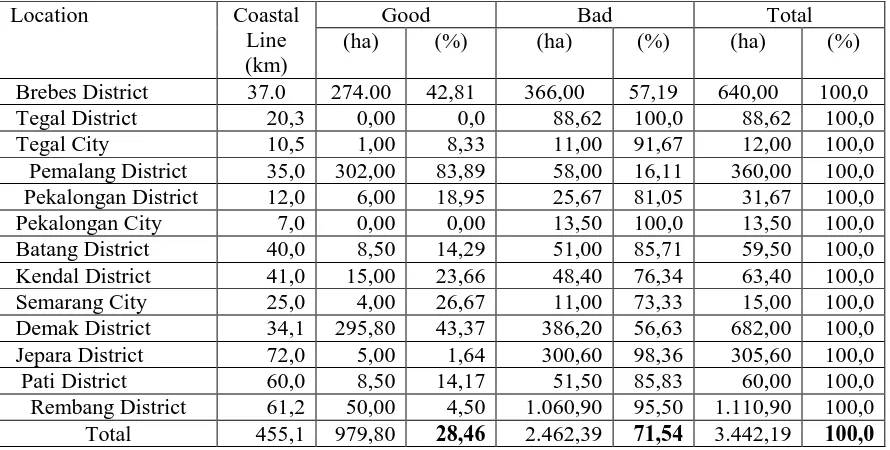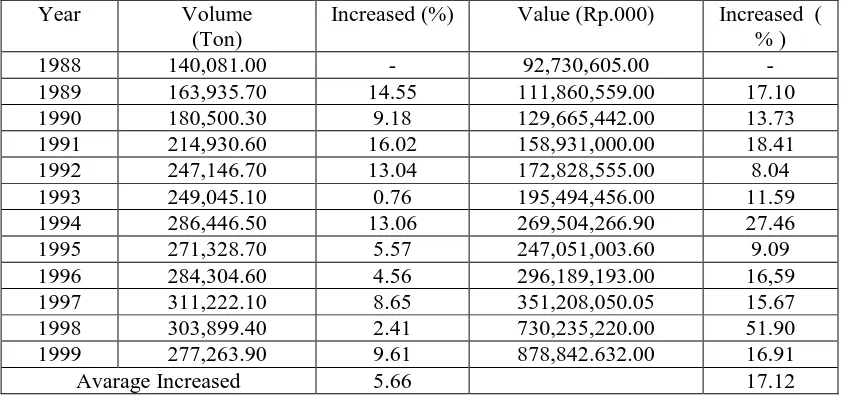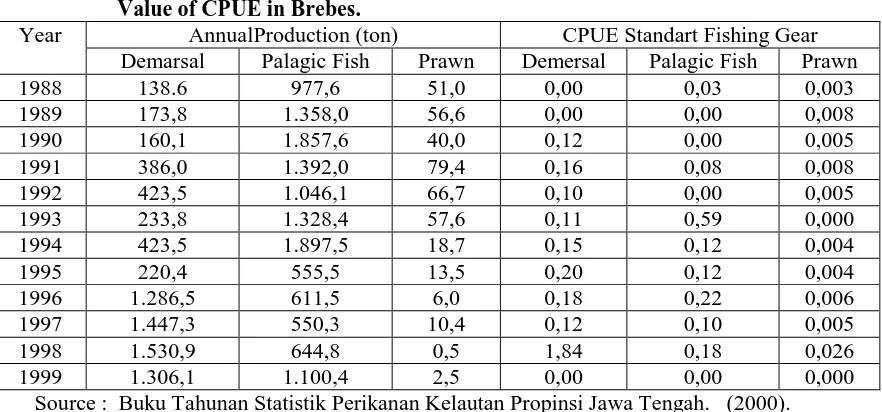Original paper
DOES MARINE FISHING CAPTURE DECLINE IN NORTH COAST OF CENTRAL JAVA?
Supriharyono*)
Faculty of Fishery and Marine Science, Diponegoro University
Semarang 50275, Indonesia
Received August , 2003; Accepted September , 2003
ABSTRACT
Marine fisheries productivity has been studied in North coast of central Java. Study
was carried out at four coastal regions, i.e Brebes, Pemalang, Jepara , and Rembang from July to October 2002. The primary and secondary data were collected covering the existing marine habitats, namely mangrove, sea grass meadows, coral reefs, and fishing and marine culture production.
The result showed that most marine local habitats in the North coast of central Java, mainly in the studied sites were worse. Mangrove cover, from the total of 3,442.19 ha was only 979,8 (8,46%) in good condition, while remaining areas of 2,462,39 ha (71,54%) were in critical or bad condition. Similar trends were observed in the sea grass and coral reef habitats showing the decrease of living coral cover resulted in the decline in fishing capture production.
Key Words: Mangroves, sea grass meadows, coral reefs condition, marine fisheries production
*) Correspondence: phone/fax; e-mail:
INTRODUCTION
Coastal waters are highly productive marine ecosystem in tropical areas. Primary productivity is very high, goes up to > 10 kg C/m2/yr or 50-100 times higher than which was recorded at the offshore (Gordon and Kelly, 1962). The coastal areas have main roles as spawning, nursery, and feeding grounds of many marine fishes. The fisheries production, therefore, is also high in the coastal areas, i.e, 10-30 ton/ha/year.
Unfortunately, the human activities in exploiting the natural resources, such as industries, agricultural, capture of fisheries, culture of fisheries, tourism, harbor, navigation, often affect on marine resources in the coastal areas. Moreover, those activities also create negative impacts on marine systems at surrounding areas, mainly mangrove, sea grass beds, and coral reefs. Therefore, such activities need to be taken into account for coastal management in particular in relation with the marine fishing captures.
MATERIALS AND METHODS
The study was conducted in the North coast of central Java from May to October, 2002. The Discussion), related to the aim of the study, i,e accessibility of coastal resources and capture fisheries at the study sites. While, secondary data references, were collected from related institutions, including Marine and Fisheries Department, Fisheries and Marine agency, and marine researchers from various affiliated institutions.
Participants
The participants of discussion were selected fishers from each stratum of the fishers, i.e, fishing owners, both the owners and also fishers, and fishers only. Participants were proportionally chosen based on the number within fisher population.
RESULTS AND DISCUSSION
1 Existing of Supporting Habitat Condition
1.1 Mangrove
Mangroves are forest or community of plants, which grow in the coastal areas and could withstand to salinity changes. As a plant community, mangroves may have a high primary productivity, reach up to 5,000 g/C/m2/yr (Lugo and Snedaker, 1974). The high primary productivity in mangrove areas is usually functioning as spawning, nursery, and feeding grounds by several living marine organisms such as fish, and shrimp. Therefore, mangrove ecosystem affects on fish production in the coastal areas.
Mangroves grew poorly in the North coast of central Java. From a total of 3,442. 19 Diferent from Avecernnia sp that naturally occurred, species of Rhizophora sp mostly resulted from the replanting program. Such condition, therefore may affect on the fish production in the Nort coast of central Java.
Table 1. Mangrove condition in the North coast of Central Java
Source : Dinas Perikanan dan Kelautan, Propinsi Jawa Tengah (2002) Note : Printed in bold meant average
1.2 Sea grass beds
Sea grass is another marine plant community in the shallow coastal waters. As a plant community, sea grass does produce a high primary productivity. Their primary productivity has been recorded about 120 – 320 g C/m2/yr. The secondary or fisheries productivity, therefore, is also high in this ecosystem.
Sea grass beds were also observed in the North coast of central Java, mainly at Tegal, Jepara and Rembang, sharing with the corals covering six different genera, namely
Cymodocea, Enhalodule, Halophyla , Syringodium, and Thalassia. While, the dominant
species were Thalassia testudinum and Cymodosea serrulata. These plants, in majority, had poor growth. It is believed that these due to high sedimentation and other human activities on the sea grass beds, mainly boating. Living sea grass coverage was less than 10%, and those were mainly young colonies, while the old colonies, many of them were died.
1.3.Coral Reefs
Coral refs are also another productive marine ecosystem in the coastal waters with primary productivity reach up to more than 10.000 g C/m2/yr (Gordon and Kelly, 1962). The high of primary productivity resulted in that the coral reefs may be good habitat, either spawning nursery, or feeding grounds, for many marine organisms. Eventually, the secondary productivity is very high in this ecosystem.
from Jepara. While at Rembang district, the farer island could be located as far as 5 km from the land of Rembang.
The majority of the corals have poorly grown, particularly those that close to the main land, which is plenty with the human activities, such as Kartini Bay, Panjang Island, Bandengan Bay, Mandalika Island (Jepara), Karang Jeruk (Tegal), dan several islands waters which located about 300 – 400 m from Rembang. Living coral coverage was less than 50 % in those reefs, even it was only 5-10%, particularly in the reef flats. Conversely, in island which far away from the main land of Java, such as Karimunjawa Islands, Jepara and some islands in Rembang, the majority of corals tend to have better growth with a coverage reached up to more 75%.
2. Capture Fisheries Production in the North Coast of Central Java
There were several factors affecting the capture fisheries production. Among other factors were the condition of local or supporting habitats for fish production, the number and types of fishing boats, and the types of fishing techniques. It had a positive correlation between marine habitat, e.g. mangrove, sea grass meadows, coral reefs, condition and associated marine organisms in the surrounding locations.
Based on this fact, it can be predicted how the fishing capture production would be overlooked like with habitat conditions at surrounding areas. As mentioned in the previous discussion, the marine habitats, i.e. mangrove, sea grass meadows, and coral reefs, were very poor in conditions. These were suspected to affect their fishing capture production. As well, the fishing boat and fishing technique, might also affect the fishing capture production. These fisheries tools, moreover, are described as follows.
2.1.Fishing Boats Development
Fishing production may be related with the numbers of fishing boats, particularly boats which equiped with motor. The numbers of fishing boats tend to increase in the study sites from year to year, especially in the last 11 years ( Table 2)
1996 404 435 11.081 452 12.372
2.2.Marine Fishing Gears in the North Coast of Central Java
Marine fishing gears increased from year to year, along with increasing the number of fishing boats in North coast of central Java. Table 3 shows that the fishing gears, particularly, non selected gears (pukat kantong), such as payang, dogol, and pukat pantai, were significantly increased. On the other hand, the other non selected fishing gears , such as cotok not recorded in fisheries statistical report, were observed in the study sites, and the numbers tended to increase from time to time. Some of these, even, were equiped with small mesh size of nets that proved the possibility of over fishing in North coast of Central Java.
Table 3. Fishing gears development in North coast of Central Java from
1988 to 1999.
2.3.Fishing Capture Production
Fishing capture production increased about 5.66% per year in central Java since the last decade, i.e. 140,081.00 ton in 1988 to 277,263.90 ton in 1999. Production value, consequently, also increased, i.e. Rp. 92,730,605.00,- in 1988 to Rp. 878,842,632.00 in 1999 (Table 4). It also shows that the average mass production increased, but yearly production might be up and down. Biomass production tends to decline from 1995, and it significantly occurred in 1997 to 1999. In fact, their values of production always increased from year to year and it is believed due to increasing of fish prices from time to time.
Table 4. Development of marine fisheries capture in central Java from 1988 to 1999
Year Volume
(Ton)
Increased (%) Value (Rp.000) Increased ( % )
1988 140,081.00 - 92,730,605.00 -
1989 163,935.70 14.55 111,860,559.00 17.10
1990 180,500.30 9.18 129,665,442.00 13.73
1991 214,930.60 16.02 158,931,000.00 18.41
1992 247,146.70 13.04 172,828,555.00 8.04
1993 249,045.10 0.76 195,494,456.00 11.59
1994 286,446.50 13.06 269,504,266.90 27.46
1995 271,328.70 5.57 247,051,003.60 9.09
1996 284,304.60 4.56 296,189,193.00 16,59
1997 311,222.10 8.65 351,208,050.05 15.67
1998 303,899.40 2.41 730,235,220.00 51.90
1999 277,263.90 9.61 878,842.632.00 16.91
Avarage Increased 5.66 17.12
Source : Statistik Perikanan dan Kelautan Propinsi Jawa Tengah (2000).
Table 5. Potential, production and fishing pressure of large and smaller pelagic, and demersal fish in Java Sea in 1997
No. Fish Groups Area gears for pelagic fish (purse seine), demersal fish (dogol), and prawn (trammel net) tended to increase, and decreased in the end of periods, mainly in 1999.(Table 6-9). This phenomenon showed that over fishing may have occurred in the study sites. These over fishing occurred in almost all the groups of fish, i.e. demersal fish, pelagic fish and prawn.
Table 6. Fiheries production according to the group of fisheries resources and the Value of CPUE in Brebes.
Year AnnualProduction (ton) CPUE Standart Fishing Gear
Demarsal Palagic Fish Prawn Demersal Palagic Fish Prawn
1988 138.6 977,6 51,0 0,00 0,03 0,003
Source : Buku Tahunan Statistik Perikanan Kelautan Propinsi Jawa Tengah. (2000).
Table 7 . Fiheries production according to the group of fisheries resources and the value of CPUE in Pemalang.
Year Annual Production (ton) CPUE Standard Fishing Gear
Demersal Pelagic Fish Prawn Demersal Pelagic Fish Prawn
1989 4.817,0 2.836,9 1.298,8 0,28 0,18 0,065
Source : After Buku Tahunan Statistik Perikanan Propinsi Jawa Tengah (2000).
Table 8. Fiheries production according to the group of fisheries resources and the value of CPUE in Jepara
Year Annual Production (ton) CPUE Standard Fishing Gear
Demersal Pelagic Fish Prawn Demersal Pelagic Fish Prawn
1998 753,8 1.422,9 80,6 0,58 0,77 0,00
Source : After Buku Tahunan Statistik Perikanan Propinsi Jawa Tengah.
Table 9. Fisheries production according to the group of fisheries resources and the of CPUE in Rembang
Year Annual Production (ton) CPUE Standard Fishing Gear
Demersal Pelagic Fish Prawn Demersal Pelagic
Fish
1989 1.592,0 11.005,7 151,6 0,05 0,40 0,03
Source : After Buku Tahunan Statistik Perikanan Propinsi Jawa Tengah 2000.
CONCLUSION
Based on the data of CPUE and the supporting habitats for fisheries growth, it may be concluded that fisheries potential has already declined in the study sites of Brebes, Pemalang, Jepara and Rembang. This condition also proved that the marine fishing capture has already been declined in studied areas. There are several factors which affected the decrease of fisheries resources, among others were decreasing of the local conditions, such as estuarine, mangrove, sea grass beds, coral reefs, and the high fishing pressures.
REFERENCE
Gordon, M.S, and H.M. Kelly.1962. Primary productivity of an Hawaiian coral reef. A critique of flow respirometry in turbulent waters . Ecology. 43: 473-480
Ryther, J.H. 1959. Potential productivity of the sea. Science. 130 : 602-608
Dinas Perikanan. 2000. Laporan Kegiatan : Evaluasi dan pemantauan bakau dalam Pemerintah Propinsi Jawa Tengah, Semarang dalam upaya menunjang produktivitas usaha budidaya tambak di pantai utara Jawa Tengah. (Indonesian)
Direktorat Jenderal Pesisir dan Pulau-Pulau Kecil, Departemen Kelautan dan Perikanan. 2000. Naskah Akademik Pengelolaan Wilayah Pesisir. (Indonesian)
Pherado, F. 2002. Pembagian kelas konservasi ekosistem terumbu karang di Karang Jeruk, Tegal, Skripsi, Jur. Ilmu Kelautan, Fakultas Perikanan dan Ilmu Kelautan, Universitas Diponegoro, Semarang. (Indonesian).
LPPSP. 2002a. Pengendalian abrasi dan pengembangan kawasan sabuk hijau dengan pendekatan community base (Belajar dari Kota Tegal). Makalah Seminar. (Indonesian)
Macnae, W. 1968, A general account of the fauna and flora of mangrove swamps and forest in the Indo-West-Pacific region. Adv. Mar. Biol. 6: 73-270
Mann, K.H. 1973. Seaweeds : Their productivity and strategy for growth. Science. 182: 975-981
Salm, R.V. 1984. Man’s use of coral reefs. In Kenchington, R.A. and B.E.T. Hudson (eds) Coral Reef Management Handbook. UNESCO-ROSTSEA, Jakarta. pp 15-22.
Subdin Bina Sumberdaya Kelautan , Dinas Perikanan dan Kelautan , Kab.Rembang 2002 Rehabilitasi penanaman bakau pada pesisir pantai Kabupaten Rembang. (Indonesian).
Supriharyono. 2000. Pelestarian dan Pengelolaan sumberdaya alam di wilayah pesisir tropis. P.T.Gramedia Pustaka Utama, Jakarta. (Indonesian).



